The first European settlers of western North Carolina were Scotch Irish mountain people
who migrated down the Appalachians in search of better land during the late 1700's.
Many of their ancestors entered the country in the northeast and migrated through the years
into the mountains where these independent people found privacy and avoided the prejudice
they encountered in the cities.
The earliest settlers came to northern Georgia in the early 1800's.
At this time the area was considered Cherokee land.
In search of gold, the settlers had little in common with the Cherokees.
Soon the Cherokees were driven west. Some fled higher up into the mountains.
Land lotteries sold off the Cherokee land to people from many other areas of the state and country.
Not many years later, the gold rush moved to California,
leaving behind an impoverished area with poor roads.
The early settlers had a difficult life.
They could not afford what city people took for granted.
Many of the houses and furnishings were home made.
Some cut down trees to build log homes.
These were not the sort people build today.
The logs were not smooth or uniform, and were sometimes used without removing the bark.
The gaps were filled with clay mud and stones, which often needed repairing.
There are many stories of snow blowing through the logs into their bedrooms.
Chimneys were built of locally found rocks stacked with red clay as mortar.
They were used for heating and cooking.
The preferred home was frame. The walls were studded and sided in locally milled wood.
Many used pine for the studs and poplar for the siding, oak or pine for the floors.
Even the interior wall surfaces were paneled with wood.
Frame homes did a better job of keeping out the winter wind.
They were also built small to save cost and heat.
With little time or money for fancy ornament, these homes were simple and practical.
Long narrow porches provided extra living space, with protection from the heat and rain.
The shade cooled the summer breezes.
The room with the fireplace had the dining table, the cooking area,
and the chairs for sitting in the evening.
The bedroom was at the other end of the home.
The children slept in the attic, which was usually not finished as well as downstairs.
A roof came down very low on the sides over the sleeping attic.
The gabled ends had a small window for light and air.
Later versions of this style added a single long shed dormer in the front.
This increased the usable space for a large family.
These mountain home were similar to the smaller farm house style
and to the bungalow style built in other areas of the country.
It was popular in the southern Appalachians for over 100 years,
and is in my opinion, the most authentic style for our area.
* New wave of settlers
The automobile completely changed mountain life.
In the first half of the twentieth century, roads spread like forest fire.
Because roads are more difficult and costly to build in the mountains,
the Appalachians were always behind the rest of the country.
This kept the mountain culture more old fashioned.
This quaint cultural difference attracted many tourists
seeking relief from the pressures of modern society.
Motels and tourist camps sprung up along the new highways.
Many of these were started by former tourists who saw a way to make a living from this influx,
giving them the opportunity to live in the mountains.
They brought with them their own ideas of how a mountain cabin should look.
Often these ideas came from books and magazines with pictures
from the mountains of Canada, Switzerland, and other countries.
Others who came saw these as the "authentic" mountain style.
This style has been named "mountainesque".
It has come to include massive dark stained wood timbers, a lot of rustic rockwork,
milled log shaped timbers, ceilings that reach the sky, and lots of tall glass overlooking a view.
This style has its roots in the mountains of central and northern Europe, not in the Appalachians.
While there is nothing wrong with building in this style, it is not a true Appalachian tradition.
This style is no more authentic for this area
than a southwestern Pueblo style, or a sleek modern style home.
I would like to show some examples of the progression of styles of mountain homes.
This was an unusually refined home for its time.
Notice how the angle of the roof over the gables
matches the angle of the roof over the ends of the front porch.
The main part of the home is symmetrical.
This attractive roofline was very common in this time.
But, it was also practical, providing better protection over the gable windows in the sleeping attic.
The shed dormer adds light and ceiling height to the sleeping attic.
This style of dormer was much better than the typical colonial style home with several narrow gable dormers.
The larger shed dormer provided more usable space, was easier and less expensive to construct,
and made for a stronger roof.
This home was probably built in the 1920's.
In conclusion, there is no real authentic style for the Southern Appalachians. A well designed home does not need to copy the past, when the economy, construction methods, and the needs of people were different. Homes should first be designed to satisfy the needs of the people who will be living them. They should be affordable, energy efficient. They should fit their site. They should reflect good building practices for our time. There are many good ways to achieve these goals and have a beautiful mountain home. Put these principles ahead of the style of the home, and the results will be much better.
To preserve the privacy of these homeowners, I chose these photos from random areas in the mountains without giving any clues as to where they are located. Any statements about quality of construction and design are only for the purpose of educating people on good building methods in our time, not as judgment of the quality of the specific home.
How to Contact The Mountain Home Show
Appreciation......
This web site contains information obtained from various sources.
The Mountain Home Show is not liable for the accuracy of this information.
Please contact the source of this information with your questions.
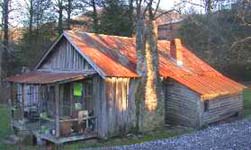
This is a typical home for the earliest of settlers,
and was a common style from the early 1800's until the 1930's.
Originally built with handsplit oak shingle roof, all the materials were obtained locally.
The trees that were cleared for the home were cut into lumber to build the home.
Perhaps the owner bartered some of the cut wood for the labor of the sawmill.
Originally blacksmiths made iron nails by hand to construct these homes.
Often nails, hinges, and windows were the only items purchased when building.
Stones and clay taken from the property
were used to construct the foundation piers and the fireplace.
The main part of the home is constructed with board and batten siding, still common today.
The addition on the right has horizontal lap siding, the other original siding for our area.
This unpainted wood could be 100 years old, and is still in fairly good condition!
The smaller chimney was a later addition for a kerosene heater.
This style home was the most common, the home for the average mountain person.
Very few are seen today, as the poor residents could not afford to preserve them as well
as were some of the larger homes.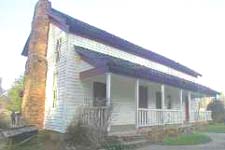
This is a restored Appalachian farmhouse from the middle 1800's.
The roof is hand split oak shingles.
The siding is locally harvested hardwood, sawed in a local mill.
The chimney and foundation are built with rocks from the property.
It was not unusual to have several entry doors from the front porch.
The porch railing and columns were of of a shape that was easy to produce in a sawmill.
The residents could afford a full second story, not common in the Appalachians then.
I am not sure that a person of this time could afford to buy paint to keep their home white either.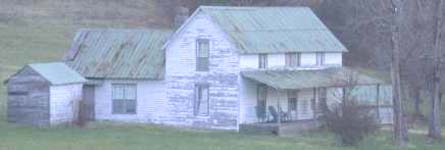
This is a very typical Appalachian style farmhouse for the late 1800's and early 1900's.
Notice the long, narrow shape of the main two story section, and of the front porch.
The back addition was probably a more modern kitchen.
These were often added in the 1930's and 1940's.
Originally these homes were roofed with hand split oak shingles from locally cut trees.
Metal roofs were often installed right over the oak in the middle 1900's.
There are signs that the original residents were more successful than average.
At greater expense, the entire roof over the sleeping attic was built higher
to provide window space along the front and more headroom inside.
The windows and door along the front porch are symmetrical too.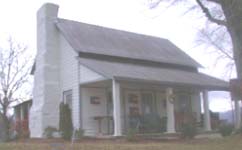
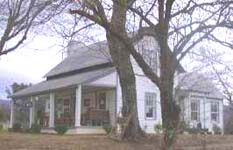
While the windows are from the 1930's or 1940's, the stone masonry chimney
dates this typical Appalachian farmhouse to the middle to late 1800's.
Additions were constructed in the back for kitchen and dining space.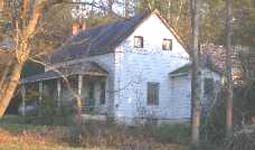
This in-town home could be from the late 1800's.
The small sleeping attic windows indicate that this home may have been built
when glass was more expensive before 1900.
The raised roof over the sleeping attic and the turned columns on the front porch
were better than average for a home of this time.
The small addition was probably for a bathroom when indoor plumbing arrived in the mountains.
The siding is not original. It appears to be hardboard, popular in the 1960's.
Many installed this inferior product on their wood sided homes
to cover up problems and make the homes more weather tight.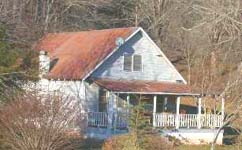
This farm home is wider than most, a change brought about by the influence
of the Craftsman and Foursquare styles popular at this time in the rest of the country.
The window in the gable is for the children's sleeping attic.
They chose a porch that wrapped around one end.
The gable roof overhang supports were often used in the 1920's to the 1940's.
The satellite dish is the only visible feature that is not original.
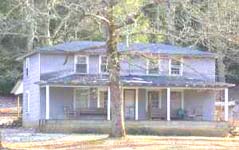
This is a farm home probably built in the early 1900's.
Because they built this home with a complete second level, a steep gable roof was not needed.
Notice the long, narrow porch, and the long narrow home. 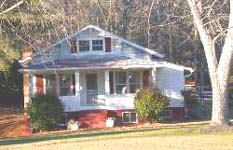
Here we have a very refined bungalow style home, probably built in the 1930's or 1940's.
This home was ahead of its time for this area, as basements were not commonly used until decades later.
The symmetrical layout shows that someone had very definite opinions of style.
But one can still see the Appalachian roots in the sleeping attic and the narrow porch. 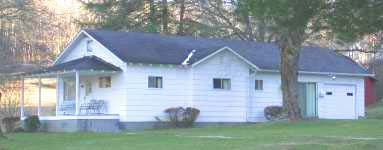
This home was originally a very small bungalow, without the garage.
Built around the 1930's we see how important a porch was back then,
as it took up about 15% of the original square footage of this tiny home. 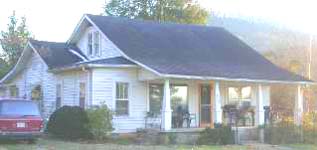
An in-town bungalow is shown here.
The sloped porch columns are a smaller version of those often seen
on Craftsman and Arts and Crafts homes in the bigger cities of the early 1900's.
Even though this home was probably built in the 1930's, it still had a sleeping attic.
The original wood siding was covered with aluminum.
Storm windows were also added. 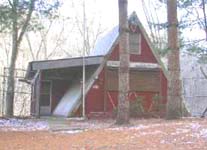
This home is called an "A- frame," named after the shape of its roof.
Its roots are in the chalets of Switzerland.
This style was popular here in the sixties and early seventies
for a weekend cabin or vacation home for people from Florida or Atlanta.
Being narrow, it was easy to build on a steep lot, but the slanted,
windowless side walls inside the roof were a problem for many. 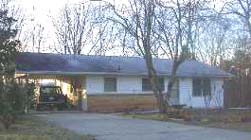
As a response to the baby boom after World War II,
the government established programs to encourage renters to buy their first home.
These homes were built on a very tight budget with materials and methods
that were considered modern at the time.
This Ranch style home featured a little splash of brick to give the idea of quality.
But, often these homes were designed for quick sales instead of quality.
Many of our first mountain subdivisions had this type of home.
To decrease cost, this Ranch style home was built
on a property that was too steep for this plan.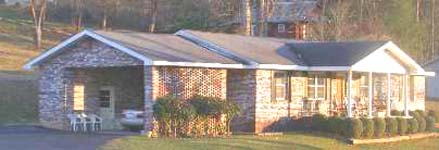
Beginning in the 1950's many local residents began to benefit
from the increased business activity in the mountains.
They responded by building modern ranch style homes.
Most of them had colonial styled ornamentation, like this example with "antique" brick,
shutters, and a front porch with columns. One advantage of these long narrow ranch homes
was that they fit sloped properties quite well.
This one was probably built in the 1970's.
Here we have a Mountainesque style home.
This style began to be built here around the 1960's.
It was developed from mountain lodges of the Rocky Mountains and the Adirondacks,
which got there styling from the rustic wood structures
of the mountains in north and central Europe.
Developers have built so many of these that many think
this is an authentic style for the Appalachians.
If one wants to build a home of this style,
it would be important to be very careful which direction the glass faces,
to avoid making the home extremely uncomfortable and difficult to heat and cool.
This style has changed through the years to reflect developments
in building materials and changes in building costs.
Some are sided in vinyl or wood. Others are built of log or timber frame.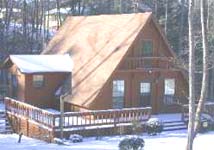
This is another Mountainesque style home
that has some of its styling from the Swiss Chalets,
minus the intricate wood detailing.
The roof comes down almost low enough to be considered an "A Frame."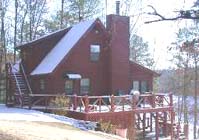
This Mountainesque style home does not really have log walls.
It has wood siding milled to resemble logs,
a solution for those who want a home that looks like logs
without as much cost or maintenance.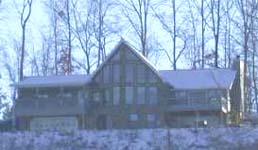
Here we have a Mountainesque home with a rock veneer.
The central section is a massive lodge styled great room.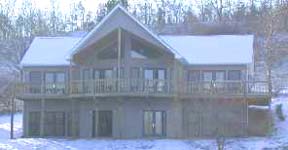
Here is a Mountainesque home with modern details.
The siding is vinyl, and the roof is supported with pre-engineered scissor trusses to save cost.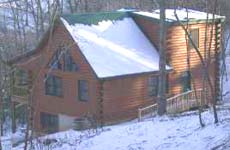
This Mountainesque home is built of milled logs.
Many log home manufacturers have equipment to cut round timbers from square timbers
that they purchase from timber suppliers.
Log homes require special knowledge to plan and construct to avoid serious problems.
If well planned and constructed they can bring many years of enjoyable living,
but they cost more than conventional homes of the same quality.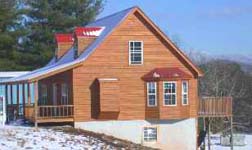
This home is an example of a style often built at this time,
having its roots in Colonial style homes of the northeastern United States.
Traditional homes in colonial times followed rigid rules of scale, balance, and symmetry.
Pseudo Colonial homes built today often disregard these rules,
making these homes look out of proportion.
The dormer windows might be too narrow or too close together.
The windows on the main level might be too far apart.
The shutters could be incorrectly sized.
If one wants to build a Colonial style home,
it is important to understand how to make it look right.
On this house there are two "bump outs." One is for a bay window.
The other is for a fireplace that does not have a chimney.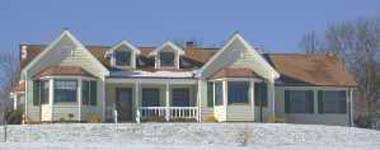
This is another Pseudo Colonial style home.
This particular example is taken from the Colonial farmhouse
that was often increased in size to accommodate the growing family.
Each addition would have a new roof line and often a different siding material.
Modern versions of these homes sometimes have fake dormers that do not open to the inside.
This large Pseudo Colonial home features a garage that resembles an addition.
This one is sided with vinyl that is supposed to look like horizontal wood lap siding.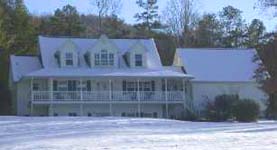
This Pseudo Colonial home has a feature that has been seen in our area since the 1990's,
dormers of varying size. Usually the largest is in the center,
providing a very high ceiling for the formal entry.
The two story wrap around porch adds a homey touch
while providing a means for cool summer breezes inside.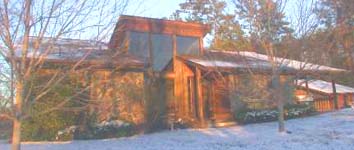
We are seeing more people who want a unique home on their mountain property.
They see no need to build a home that is of the Mountainesque or Pseudo Colonial styles
because they are not really authentic styles for the southern Appalachians.
They feel free to use modern ideas to design their home.
This one features a blend of rock veneers and rough wood siding
and was probably built in the 1980's.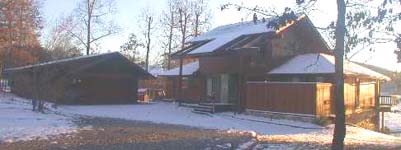
This is a recently built modern styled home.
While using elements of the Mountainesque style with heavy timbers and rustic wood siding,
imagination was used to have a unique home that is well suited for this property with a view.
Snow adds the icing on the cake.
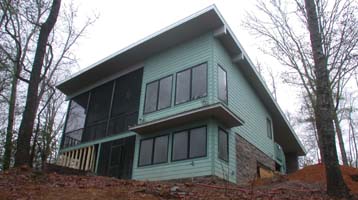
There is a new interest in green homes.
Rising energy costs and increased environmental awareness are driving this.
While green doesn't have to be modern, most enviro- conscious people prefer this style.
By designing homes to take the best advantage of the sun, heating and cooling costs are reduced,
and the home is much more comfortable.
These clients don't want a huge mansion.
They want a better planned home that costs less to build, is easier to keep comfortable, and requires less time to maintain.
With the money saved, they are willing to invest in better quality.
How to Contact Richard C. MacCrea
 My Facebook Page
My Facebook Page
(Design news and ideas)
Email Me
(Opens an email window)
800.738.8781 P.O. Box 446, Murphy, North Carolina 28906
Other Pages on this Web Site
 The Mountain Home Show, Home Page and Site Map
The Mountain Home Show, Home Page and Site Map
(How to find what you're looking for)
The Next Mountain Home Show Program
(For guests and exhibitors)
How to Get in The Mountain Home Show
(For exhibitors)
Articles
(About designing, building and remodeling a mountain home)
The Mountain Model Home
(A home that experiments with extreme energy efficiency)
The Mountain Model Cabin
(A cabin that experiments with small size and energy efficiency)
Construction Diary
(The joys and frustrations of building these two model homes)
Home Designing and Planning
(How to get plans for building or remodeling your home)
 Email Us
Email Us
(Opens an email window)
Like our Facebook Page
(Join our Mountain Home Show Community for news and contacts)
The Mountain Home Show, P.O. Box 446, Murphy, North Carolina 28906-0446
The Mountain Home Show owes its success to the businesses that participate in the show.
They arrange such wonderful exhibits.
It is obvious that they take great pride in their work and our show.